Effective Methods to Cut Cost Per Call in 2025

Cost per call (CPC) measures the expense of handling a single customer interaction in a call center. It plays a vital role in evaluating operational efficiency. For instance, the average cost per inbound call ranges from $2.70 to $5.60 for basic inquiries, while complex technical support calls can cost up to $15.00. Reducing CPC without compromising service quality is crucial, especially as industries like financial services and healthcare face higher costs, often exceeding $7.00 per interaction.
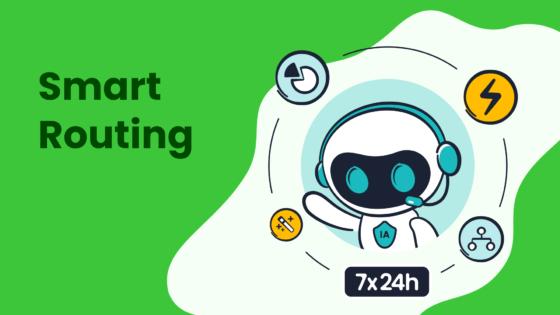
AI and automation have revolutionized cost reduction strategies. Fully automated AI-powered interactions can lower costs by 60-80%, handling routine inquiries for just $1-$2 per interaction. Tools like Sobot's Voice/Call Center leverage AI to streamline workflows, reduce average handle time, and improve first-call resolution rates. These advancements not only cut costs but also enhance customer satisfaction, making them indispensable for call centers in 2025.
Understanding Cost Per Call (CPC)
What Is Cost Per Call?
Definition and its role in call center efficiency.
Cost per call measures the average expense of handling a single customer interaction. This includes all associated costs, such as labor, technology, and overhead. It serves as a vital metric for evaluating the efficiency of your call center operations. By understanding this metric, you can identify inefficiencies and implement strategies to improve performance.
For example, if your call center handles 22,000 calls monthly with total call center costs of $75,000, the cost per call would be $3.40. This calculation helps you assess whether your operations are cost-effective and where improvements are needed.
Why CPC is a critical metric for operational success.
Cost per call plays a crucial role in optimizing your call center's performance. It provides insights into operational efficiency, highlights areas for potential savings, and ensures that cost-cutting measures do not compromise service quality. Accurate CPC calculations also aid in budgeting and forecasting, helping you allocate resources effectively.
| Aspect | Description |
|---|---|
| Definition | Cost per call measures the average cost of handling a single call, including all associated expenses. |
| Importance | It provides insights into operational efficiency and highlights areas for potential cost savings. |
| Operational Efficiency | Identifying inefficiencies allows for strategies to improve efficiency and reduce expenses. |
| Budgeting and Forecasting | Accurate calculations aid in setting realistic goals and resource allocation. |
| Balancing Cost and Quality | Ensures that cost-cutting does not negatively impact customer service quality. |
How to Calculate Cost Per Call
Standard formula for calculating CPC.
To calculate cost per call, divide the total call center costs by the total number of calls answered. For instance:
| Total Call Center Costs | Total Calls Answered | Average Cost Per Call |
|---|---|---|
| $75,000 | 22,000 | $3.40 |
| $70,000 | 15,000 | $4.60 |
This formula provides a clear picture of your call center's cost efficiency. Regularly monitoring this metric ensures you stay on track with your financial goals.
Key cost components: labor, technology, and overhead.

Labor costs form the largest portion of call center costs. These include salaries, benefits, and training expenses for agents. High-performing agents can resolve issues faster, reducing the cost per call. Technology costs, such as software and hardware, also play a significant role. Tools like Sobot's Voice/Call Center help streamline operations, reducing average handling time and improving efficiency. Overhead costs, including utilities and office space, complete the picture. Together, these components determine your overall cost per call.
Strategies to Reduce Cost Per Call
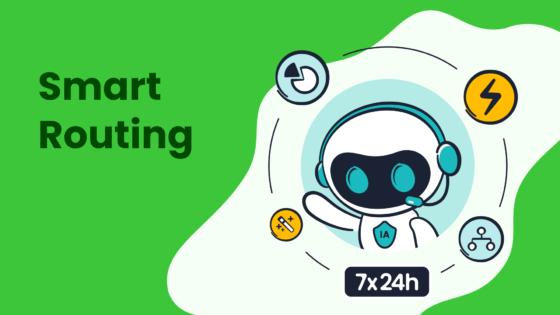
Leveraging Technology for Cost Reduction
AI-powered tools like Sobot's Voice/Call Center for smarter call handling.
AI-powered tools have transformed how call centers operate, offering smarter ways to handle customer interactions. For example, Sobot's Voice/Call Center uses AI to automate simple tasks like call routing and customer verification. This reduces the workload on agents and ensures faster resolutions. Features like intelligent IVR and AI-powered voicebots allow you to handle routine inquiries efficiently, cutting costs by up to 22%. Additionally, AI improves first call resolution rates by providing agents with real-time insights, which reduces repeat calls and operational costs.
A mid-sized healthcare organization implemented an AI-powered IVR system and handled 28% of inquiries without agents. This reduced costs by 22% while maintaining high satisfaction levels. Similarly, a major publisher saved over $1 million annually by using predictive models to optimize call handling. These examples show how AI tools can significantly reduce call center costs while improving service quality.
Cloud-based solutions to minimize infrastructure costs.
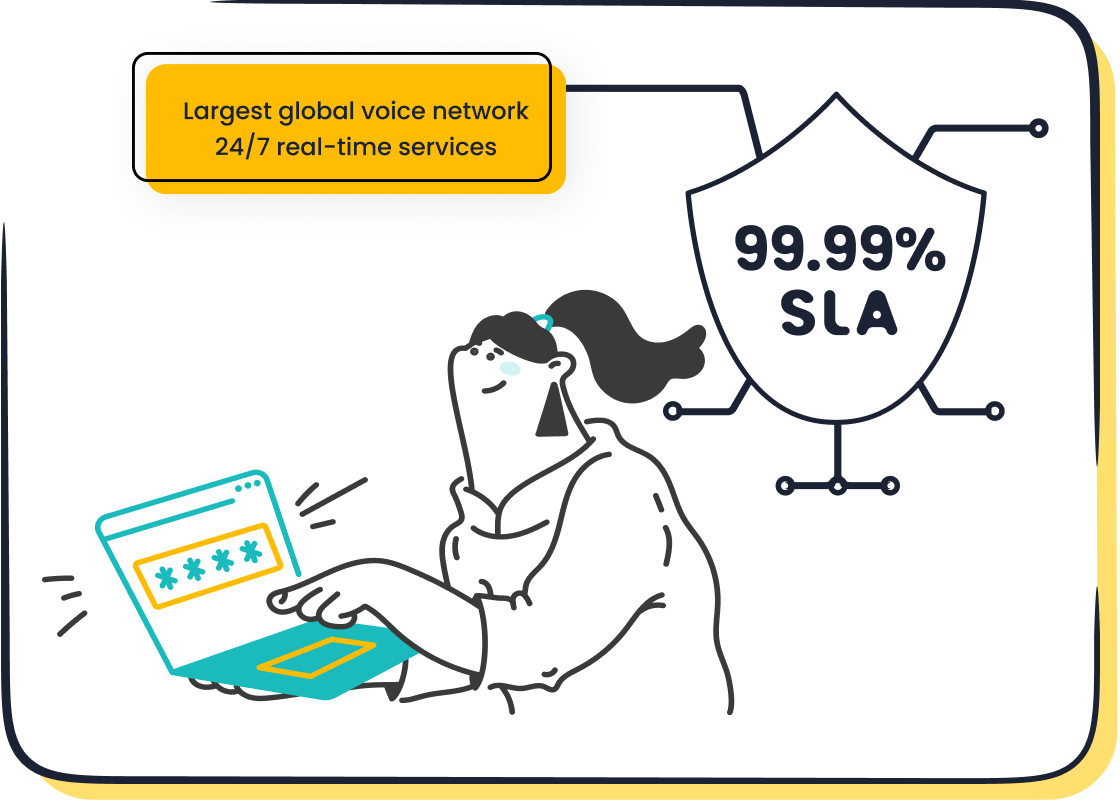
Cloud-based solutions eliminate the need for expensive on-site infrastructure. By adopting platforms like Sobot's Voice/Call Center, you can access global telephony services without investing in physical hardware. Cloud systems also offer scalability, allowing you to adjust resources based on call volume. This flexibility minimizes waste and ensures cost efficiency.
For instance, cloud-based systems reduce maintenance costs and downtime, which directly impacts your cost per call. With Sobot's 99.99% system uptime, you can ensure uninterrupted service while keeping operational costs low. The economic SaaS rental model further simplifies budgeting, making it easier to manage expenses.
Optimizing Workforce Management
Effective agent scheduling to reduce idle time.
Optimized scheduling ensures agents are neither overworked nor underutilized. Predictive analytics can forecast call volumes, helping you align staffing levels with demand. A leading telecommunications provider improved scheduling efficiency and reduced the average cost per call from $8.25 to $6.70—a 19% reduction in six months.
Metrics like schedule adherence and agent productivity play a key role here. Proactive monitoring ensures agents stick to their schedules, reducing idle time. Tools like Sobot's unified workspace provide real-time data, enabling better workforce management and improving overall efficiency.
Training programs to improve first-call resolution rates.
Training programs equip agents with the skills needed to resolve issues on the first attempt. Higher first call resolution rates mean fewer repeat calls, which lowers your cost per call. Personalized coaching and AI-driven insights can enhance agent performance significantly.
For example, a financial services firm used predictive analytics to identify training gaps, improving first call resolution rates and reducing costs by 15%. Sobot's Voice/Call Center supports this by offering a 360-degree customer view, enabling agents to address issues more effectively.
Enhancing Operational Efficiency
Streamlining workflows to reduce average handling time.
Streamlined workflows help agents resolve queries faster, reducing average handling time (AHT). Digital adoption platforms simplify tool usage, while CRM integration provides a complete customer view. These improvements enhance agent productivity and reduce costs.
Monitoring key performance indicators like AHT and first call resolution rates helps identify inefficiencies. Empowering agents with tools like Sobot's unified workspace ensures quicker resolutions. A reduction in AHT not only decreases labor costs but also improves customer satisfaction.
Outsourcing non-core tasks to specialized providers.
Outsourcing non-core tasks like data entry or basic customer inquiries can free up resources for more complex issues. Specialized providers handle these tasks efficiently, reducing operational costs. This strategy allows you to focus on core activities while maintaining service quality.
For example, outsourcing helped a large telecommunications company achieve a 20% reduction in cost per call. By delegating routine tasks, you can optimize your resources and improve overall efficiency.
Balancing Cost Reduction with Service Quality
Prioritizing Customer Experience
Maintaining quick response times and personalized service.
Quick response times and personalized service are essential for delivering high-quality service while managing costs. Metrics like First Response Time (FRT) and Average Resolution Time (ART) help you measure how efficiently your call center resolves customer issues. For example, shorter FRTs often lead to higher satisfaction levels, as customers feel valued when their concerns are addressed promptly. Similarly, reducing ART ensures faster resolutions, which lowers the cost per call and enhances customer experience.
Personalized service also plays a key role in balancing cost and quality. Self-service tools, such as AI-powered chatbots or IVR systems, allow customers to resolve simple issues independently. This reduces the workload on agents, enabling them to focus on complex queries. Tools like Sobot's Voice/Call Center provide intelligent routing and a unified workspace, ensuring agents have the information they need to deliver tailored solutions. These strategies not only improve service quality but also contribute to cost reduction.
Regularly monitoring customer satisfaction metrics.
Tracking customer satisfaction metrics ensures you maintain a balance between cost reduction and service quality. Metrics like Customer Satisfaction Score (CSAT) and Net Promoter Score (NPS) provide insights into customer sentiment. High scores indicate that your call center delivers high-quality service, even as you optimize costs.
| Metric | Description |
|---|---|
| First Response Time (FRT) | Measures how quickly customers receive initial responses. |
| Average Resolution Time (ART) | Tracks the time taken to resolve issues, reflecting efficiency. |
| Customer Satisfaction Score (CSAT) | Gauges customer satisfaction through feedback surveys. |
| Net Promoter Score (NPS) | Assesses customer loyalty and overall sentiment. |
By analyzing these metrics, you can identify areas for improvement and ensure your cost per call remains competitive without compromising service quality.
Avoiding Over-Automation Pitfalls
Balancing human agents with AI-driven automation.
AI-driven automation offers significant cost reduction benefits, but over-reliance can harm customer service. Striking the right balance between automation and human interaction ensures you maintain high-quality service. For instance, self-service tools like Sobot's AI-powered voicebots handle routine inquiries efficiently, reducing costs. However, complex issues often require human empathy and expertise. Combining AI with skilled agents allows you to address diverse customer needs effectively.
A financial services firm implemented AI for basic queries while reserving human agents for complex cases. This approach reduced costs by 18% and improved customer satisfaction by 25%. By leveraging both AI and human agents, you can optimize operations while maintaining a personal touch.
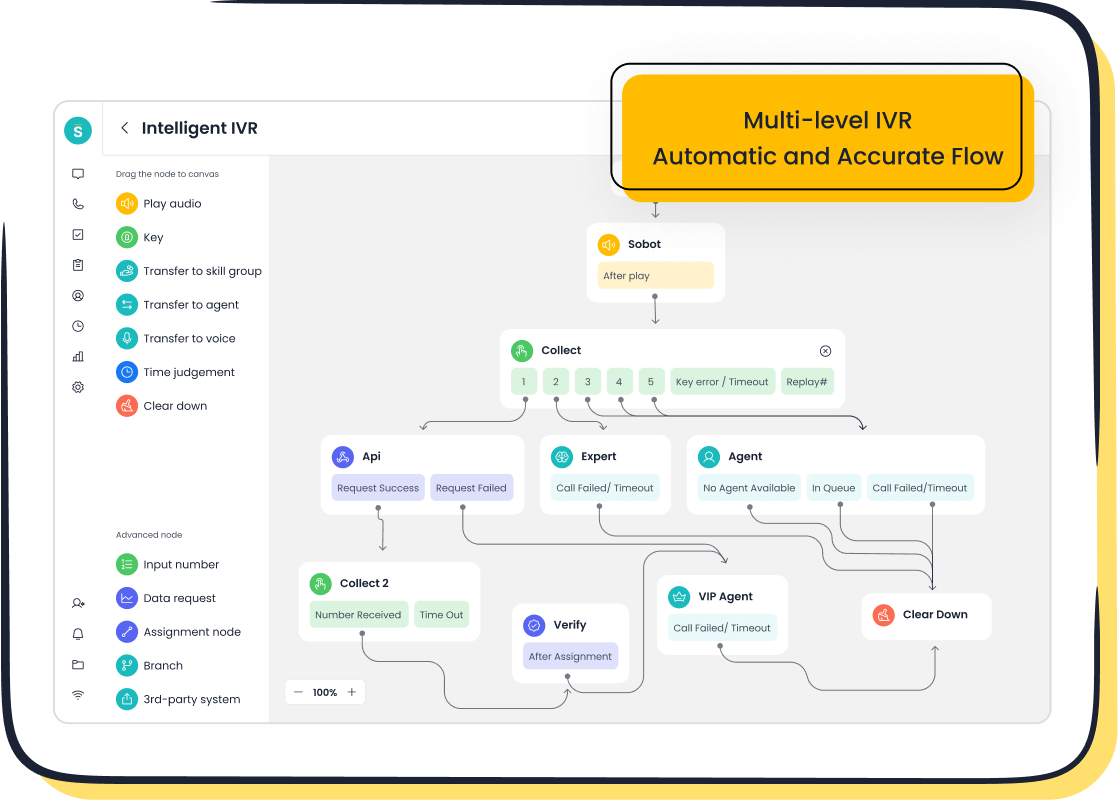
Using tools like Sobot's Voice/Call Center to enhance human interactions.
Sobot's Voice/Call Center enhances human interactions by equipping agents with advanced tools. Features like intelligent IVR and real-time data analytics streamline workflows, enabling agents to focus on delivering personalized solutions. The platform's unified workspace consolidates customer information, helping agents resolve issues faster and more effectively.
For example, skills-based routing ensures calls reach the most qualified agents, leading to quicker resolutions and higher satisfaction rates. Geographic routing connects customers to nearby support centers, improving service quality by addressing local needs. These features demonstrate how Sobot's solutions help you balance cost and quality while delivering exceptional customer service.
Future Trends in Cost Management
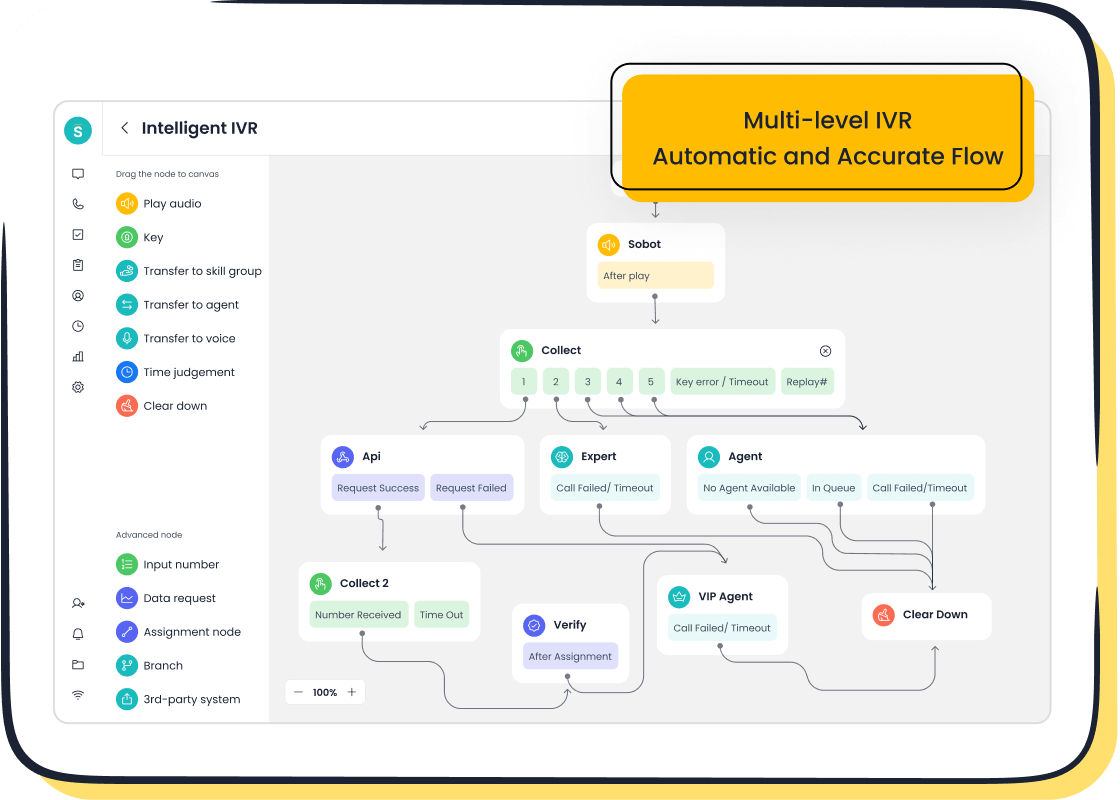
The Role of AI and Automation
Predictive analytics for resource optimization.
Predictive analytics is transforming how you manage call center operations. By analyzing historical data, it forecasts call volumes and customer behavior, enabling better resource allocation. For example, a financial services firm used predictive analytics to optimize workforce management, reducing its cost per call by 15%. This approach minimizes overstaffing and ensures agents are available during peak times, improving efficiency.
Predictive systems also help reduce the need for customer calls. They identify potential issues before they escalate, allowing agents to proactively address them. This not only enhances customer satisfaction but also reduces operational costs. Companies like Caesar's Palace use predictive mood analysis to offer personalized solutions, improving customer retention and managing costs effectively.
Real-time agent assistance with AI-powered tools.
AI-powered tools provide real-time feedback to agents, enhancing their performance during live interactions. These tools analyze customer sentiment and suggest solutions, reducing average handling time (AHT). For instance, 70% of customers expect immediate service, and real-time AI assistance helps meet this demand, lowering operational costs.
Sobot's Voice/Call Center equips agents with real-time insights through its unified workspace. This feature ensures faster resolutions and improves first-call resolution rates. By combining AI with human expertise, you can reduce call center costs while maintaining high service quality.
Emerging Technologies in Call Centers
Voice recognition and natural language processing.
Advancements in voice recognition systems, powered by deep learning models like recurrent neural networks (RNNs), have revolutionized call center operations. These technologies enable machines to understand complex speech patterns, improving the accuracy of IVR systems. Conversational AI further enhances interactions, making them more human-like and boosting customer satisfaction.
For example, integrating voice recognition with natural language processing allows call centers to handle routine inquiries more efficiently. This reduces the workload on agents and lowers the cost per call. As these technologies evolve, they will play a crucial role in cost reduction strategies.
Omnichannel communication platforms like Sobot's solutions.
Omnichannel platforms unify customer interactions across multiple channels, streamlining operations and reducing costs. Sobot's Voice/Call Center integrates voice, email, and social media into a single system, ensuring seamless communication. This approach eliminates the need for multiple tools, saving time and resources.
For instance, a telecommunications company implemented an omnichannel platform and achieved a 20% reduction in cost per call while maintaining high customer satisfaction. By adopting such solutions, you can enhance operational efficiency and improve customer experience.
Sustainability and Remote Work
Eco-friendly practices to reduce operational costs.
Sustainability initiatives can significantly reduce call center costs. For example, switching to energy-efficient systems and reducing paper usage lowers overhead expenses. Companies that adopt eco-friendly practices not only save money but also enhance their brand image.
Remote work also contributes to sustainability. By reducing the need for office space, you can cut utility costs and minimize your carbon footprint. These practices align with modern business values while improving operational efficiency.
Remote work models for global call center teams.
Remote work has become a game-changer for call centers. Studies show that companies save over $11,000 per employee annually when employees work remotely half the time. Additionally, performance increases by 13% when agents work from home, according to a Stanford University study.
Sobot's Voice/Call Center supports remote teams with features like global number availability and encrypted data transfer. These tools ensure secure and efficient operations, enabling you to manage a distributed workforce effectively. By embracing remote work, you can reduce call center costs and improve employee satisfaction.
Key Takeaways for 2025
Summary of Effective Strategies
Recap of technology, workforce, and operational strategies.
Reducing the cost per call in 2025 requires a multi-faceted approach. Technology plays a pivotal role, with tools like Sobot's Voice/Call Center enabling automation, intelligent call routing, and real-time analytics. These innovations streamline operations and improve efficiency. Workforce development is equally critical. Regular training programs and predictive scheduling empower agents to deliver exceptional service while minimizing idle time. Operational strategies, such as outsourcing non-core tasks and adopting cloud-based solutions, further enhance cost efficiency.
| Strategy | Description |
|---|---|
| Embrace Technology | Adoption of automation tools and cloud-based solutions to enhance efficiency and productivity. |
| Invest in Workforce Development | Ongoing training and support for agents to empower them in delivering outstanding service. |
| Adapt Operational Strategies | Adjusting strategies to meet changing customer expectations and market shifts. |
By integrating these strategies, you can achieve a balance between cost reduction and service quality, ensuring your call center remains competitive.
Emphasis on balancing cost reduction with service quality.
Cost reduction should never come at the expense of customer satisfaction. Advanced tools like Sobot's Voice/Call Center help you maintain this balance by combining AI-driven automation with human expertise. For instance, AI-powered IVR systems handle routine inquiries, while skilled agents focus on complex issues. This approach reduces costs and enhances the customer experience. A healthcare organization that implemented such a system reduced costs by 22% while maintaining high satisfaction levels. These results highlight the importance of aligning cost-saving measures with service excellence.
Call to Action
Encouragement to adopt tools like Sobot's Voice/Call Center.
Adopting advanced tools is essential for future-ready call center operations. Sobot's Voice/Call Center offers features like intelligent IVR, unified workspaces, and AI-powered voicebots. These tools improve first-call resolution rates, reduce average handling time, and enhance customer satisfaction. For example, organizations using Sobot's solutions have achieved a 97% CSAT score and an 85% problem resolution rate. These metrics demonstrate the platform's ability to optimize operations and deliver exceptional results.

Importance of staying updated on industry trends.
Staying informed about emerging trends ensures your call center remains competitive. Predictive analytics, voice recognition, and omnichannel platforms are shaping the future of customer service. By leveraging these technologies, you can adapt to changing customer expectations and market demands. Tools like Sobot's Voice/Call Center position your business to thrive in this evolving landscape, offering scalable, secure, and efficient solutions.
Reducing the cost per call while maintaining service quality is essential for a successful call center. By leveraging technology, optimizing workforce management, and streamlining operations, you can achieve significant cost savings without compromising customer satisfaction. For instance, AI-augmented agents improve first-call resolution rates by 12%, while outsourcing can cut operational costs by up to 50% with customer satisfaction scores reaching 90%. Monitoring performance metrics ensures a balance between cost efficiency and service quality, leading to better outcomes.
Sobot's Voice/Call Center offers advanced tools like intelligent IVR and AI-powered voicebots to enhance efficiency and service delivery. These solutions help you reduce costs, improve first-call resolution rates, and maintain high customer satisfaction. Explore Sobot's offerings to future-proof your operations and achieve sustainable cost management.
FAQ
What is the average cost per call in a call center?
The average cost per call ranges from $2.70 to $5.60 for basic inquiries. Complex calls, like technical support, can cost up to $15. Tools like Sobot's Voice/Call Center help reduce these costs by automating routine tasks and improving operational efficiency. Source.
How does Sobot's Voice/Call Center reduce cost per call?
Sobot's Voice/Call Center uses AI-powered tools like intelligent IVR and voicebots to automate repetitive tasks. These features reduce average handling time and improve first-call resolution rates. For example, businesses using Sobot have cut costs by up to 22% while maintaining high customer satisfaction.
Why is first-call resolution important for reducing costs?
First-call resolution minimizes repeat calls, saving time and resources. For instance, improving this metric by 10% can reduce operational costs by 15%. Sobot's unified workspace equips agents with real-time data, enabling faster resolutions and lowering your cost per call.
Can outsourcing help reduce call center costs?
Outsourcing non-core tasks like data entry or basic inquiries can cut costs by up to 50%. Specialized providers handle these tasks efficiently, allowing your team to focus on complex issues. This strategy improves resource allocation and reduces your overall cost per call.
How does cloud technology impact call center costs?
Cloud-based solutions eliminate the need for expensive hardware. Platforms like Sobot's Voice/Call Center offer scalability and global telephony services, reducing infrastructure costs. With 99.99% uptime, Sobot ensures uninterrupted service, helping you manage costs effectively while maintaining high-quality operations.
See Also
Best Cloud Contact Center Solutions To Explore In 2024
Leading Contact Center Solutions Analyzed For 2024
Best Automated Voice Calling Software Evaluated For 2024
Ten Essential Steps For Implementing Omnichannel Contact Centers